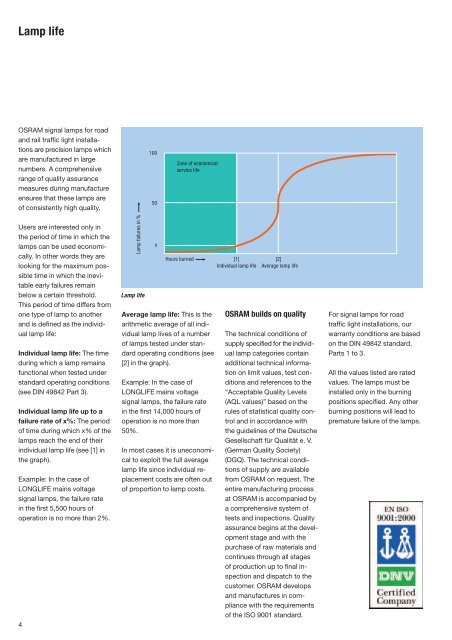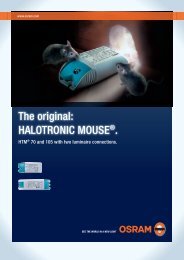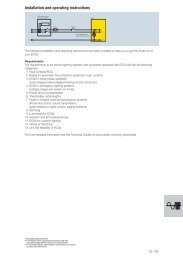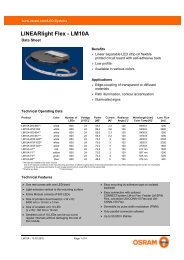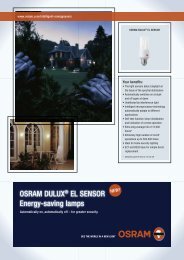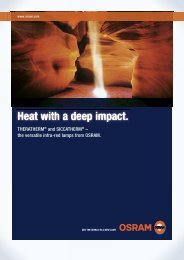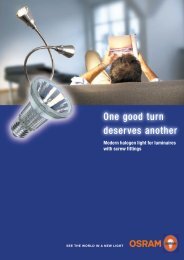Signal lamps - Osram
Signal lamps - Osram
Signal lamps - Osram
Create successful ePaper yourself
Turn your PDF publications into a flip-book with our unique Google optimized e-Paper software.
Lamp life<br />
OSRAM signal <strong>lamps</strong> for road<br />
and rail traffic light installations<br />
are precision <strong>lamps</strong> which<br />
are manufactured in large<br />
numbers. A comprehensive<br />
range of quality assurance<br />
measures during manufacture<br />
ensures that these <strong>lamps</strong> are<br />
of consistently high quality.<br />
100<br />
50<br />
Zone of economical<br />
service life<br />
Users are interested only in<br />
the period of time in which the<br />
<strong>lamps</strong> can be used economically.<br />
In other words they are<br />
looking for the maximum possible<br />
time in which the inevitable<br />
early failures remain<br />
below a certain threshold.<br />
This period of time differs from<br />
one type of lamp to another<br />
and is defined as the individual<br />
lamp life:<br />
Individual lamp life: The time<br />
during which a lamp remains<br />
functional when tested under<br />
standard operating conditions<br />
(see DIN 49842 Part 3).<br />
Individual lamp life up to a<br />
failure rate of x%: The period<br />
of time during which x% of the<br />
<strong>lamps</strong> reach the end of their<br />
individual lamp life (see [1] in<br />
the graph).<br />
Example: In the case of<br />
LONGLIFE mains voltage<br />
signal <strong>lamps</strong>, the failure rate<br />
in the first 5,500 hours of<br />
operation is no more than 2%.<br />
4<br />
Lamp failures in %<br />
Lamp life<br />
x<br />
Average lamp life: This is the<br />
arithmetic average of all individual<br />
lamp lives of a number<br />
of <strong>lamps</strong> tested under standard<br />
operating conditions (see<br />
[2] in the graph).<br />
Example: In the case of<br />
LONGLIFE mains voltage<br />
signal <strong>lamps</strong>, the failure rate<br />
in the first 14,000 hours of<br />
operation is no more than<br />
50%.<br />
Hours burned [1]<br />
Individual lamp life<br />
In most cases it is uneconomical<br />
to exploit the full average<br />
lamp life since individual replacement<br />
costs are often out<br />
of proportion to lamp costs.<br />
[2]<br />
Average lamp life<br />
OSRAM builds on quality<br />
The technical conditions of<br />
supply specified for the individual<br />
lamp categories contain<br />
additional technical information<br />
on limit values, test conditions<br />
and references to the<br />
“Acceptable Quality Levels<br />
(AQL values)” based on the<br />
rules of statistical quality control<br />
and in accordance with<br />
the guidelines of the Deutsche<br />
Gesellschaft für Qualität e. V.<br />
(German Quality Society)<br />
(DGQ). The technical conditions<br />
of supply are available<br />
from OSRAM on request. The<br />
entire manufacturing process<br />
at OSRAM is accompanied by<br />
a comprehensive system of<br />
tests and inspections. Quality<br />
assurance begins at the development<br />
stage and with the<br />
purchase of raw materials and<br />
continues through all stages<br />
of production up to final inspection<br />
and dispatch to the<br />
customer. OSRAM develops<br />
and manufactures in compliance<br />
with the requirements<br />
of the ISO 9001 standard.<br />
For signal <strong>lamps</strong> for road<br />
traffic light installations, our<br />
warranty conditions are based<br />
on the DIN 49842 standard,<br />
Parts 1 to 3.<br />
All the values listed are rated<br />
values. The <strong>lamps</strong> must be<br />
installed only in the burning<br />
positions specified. Any other<br />
burning positions will lead to<br />
premature failure of the <strong>lamps</strong>.


